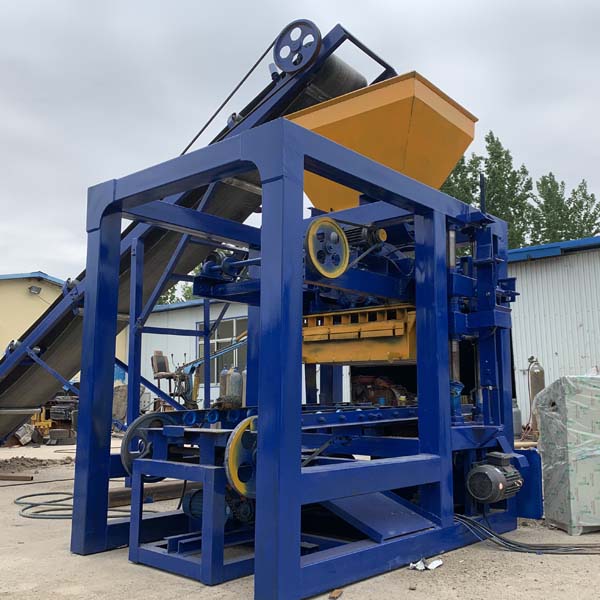
**Title: Mastering Distance: Strategies for Managing Full-Automatic Block Production in Remote Locations**
**Introduction**
Full-automatic block production, a key element in modern construction, is not confined to urban areas. In fact, the demand for construction materials often arises in remote locations where infrastructure development is critical. Managing full-automatic block production in such settings presents unique challenges that require innovative strategies. This article explores effective approaches for overseeing full-automatic block manufacturing in remote locations, ensuring efficiency, sustainability, and reliability.
**1. **Modular and Portable Production Units:**
* **Strategy:** Invest in modular and portable full-automatic block production units that can be easily transported to remote locations. These units are designed for rapid setup and operation, providing flexibility and minimizing the need for extensive infrastructure.
**2. **Local Material Sourcing:**
* **Strategy:** Optimize full-automatic block production by sourcing raw materials locally. Identify regional suppliers for aggregates, cement, and other essential components to reduce transportation costs and support the local economy.
**3. **Off-Grid Energy Solutions:**
* **Strategy:** In remote locations with limited access to the power grid, implement off-grid energy solutions. Utilize solar, wind, or hybrid power systems to ensure a continuous and sustainable energy supply for the full-automatic block manufacturing process.
**4. **Efficient Logistics and Supply Chain Management:**
* **Strategy:** Develop streamlined logistics and supply chain management systems. Plan for efficient transportation of raw materials to the production site and establish reliable distribution channels for delivering finished blocks to construction projects in remote areas.
**5. **Local Workforce Training:**
* **Strategy:** Invest in local workforce training programs to ensure that operators are skilled in the operation and maintenance of full-automatic block machines. This approach not only enhances the efficiency of production but also contributes to local employment and skill development.
**6. **Remote Monitoring and Maintenance:**
* **Strategy:** Implement remote monitoring systems for full-automatic block machines. Utilize IoT (Internet of Things) technology to gather real-time data on machine performance, enabling proactive maintenance and minimizing downtime.
**7. **Water Conservation and Management:**
* **Strategy:** In areas with water scarcity, implement water conservation measures in the production process. Optimize the use of water in mixing processes and explore alternative water sources to ensure sustainable and responsible water management.
**8. **Community Engagement and Collaboration:**
* **Strategy:** Foster positive relationships with local communities. Engage in open communication, address concerns, and collaborate with community leaders to ensure that full-automatic block production aligns with local needs and environmental considerations.
**9. **Adaptation to Local Climate Conditions:**
* **Strategy:** Consider the local climate when designing and operating full-automatic block production units. Implement measures to protect machinery from extreme weather conditions and ensure that the production process is adaptable to varying temperatures and environmental factors.
**10. **Emergency Preparedness and Contingency Planning:**
* **Strategy:** Develop comprehensive emergency preparedness and contingency plans. Consider factors such as natural disasters, road closures, or other unforeseen events that may disrupt full-automatic block production in remote locations. Establish backup systems and alternative strategies for continued operations.
**Challenges and Mitigation:**
**Challenges:**
– **Limited Infrastructure:** Remote locations may lack basic infrastructure, posing challenges for transportation, energy supply, and connectivity.
– **Skilled Workforce:** Finding a skilled workforce in remote areas may be challenging, requiring investment in training programs.
– **Environmental Considerations:** Adapting production processes to local environmental conditions and regulations may present complexities.
**Mitigation:**
– **Investment in Infrastructure:** Collaborate with local authorities and invest in basic infrastructure improvements to enhance accessibility and connectivity.
– **Capacity Building:** Implement capacity-building programs to train local workers, ensuring a skilled workforce for full-automatic block production.
– **Environmental Impact Assessments:** Conduct thorough environmental impact assessments and work closely with regulatory bodies to ensure compliance with local environmental regulations.
**Conclusion**
Successfully managing full-automatic block production in remote locations requires a combination of innovation, adaptability, and community engagement. By implementing strategies such as modular production units, local material sourcing, and off-grid energy solutions, manufacturers can overcome challenges associated with distance and contribute to sustainable and responsible construction practices in even the most remote areas.
